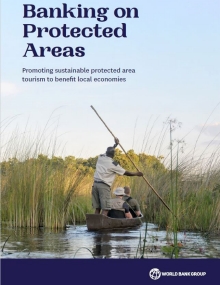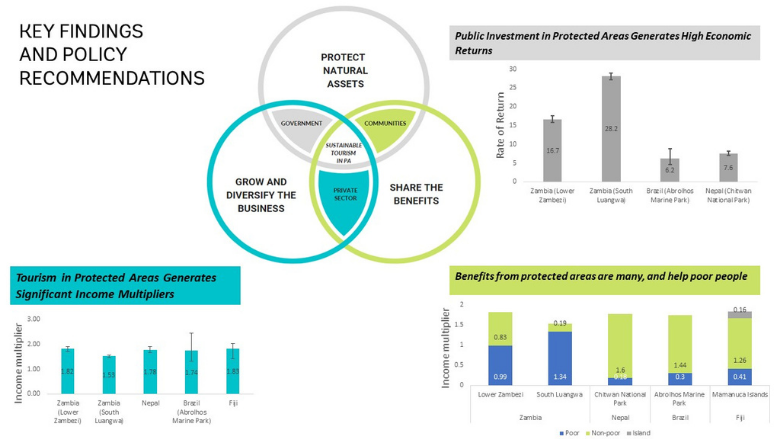
View Report launch event recording here.

View Report launch event recording here.
The conservation of biodiversity matters because of its intrinsic worth, and because ecosystem services, which depend upon biodiversity, underpin human wellbeing, and support economic activity in a range of sectors. Our survival is, finally, impossible without intact natural landscapes and seascapes. Land- and marine-based ecosystems provide food, oxygen, water, carbon sequestration, resilience in the face of climate change, and a buffer against pandemics. They also foster economic activities such as tourism, which attract eight billion visitors a year to protected areas. The need to protect these natural areas has never been greater.
At the same time, the COVID-19 pandemic has led to a deep global recession, impeding the growth of the tourism which is the largest market-based source of finance for protected areas and jeopardizing conservation efforts worldwide. These intersecting calamities – a pandemic in a time of biodiversity loss – call for a response which speaks to both crises, addressing economic losses and promoting recovery through actions which simultaneously support biodiversity conservation. Such a view brings the world’s protected areas into much-needed focus, as they are key to any global effort to contain biodiversity loss. Their role in doing so is to be deliberated at the fifteenth meeting of the Conference of the Parties (COP 15) to the Convention on Biological Diversity (CBD) this year, where threats to biodiversity and their impacts on development will be stressed, and countries will be encouraged to set aside more land and sea for conservation.
The recently launched Banking on Protected Areas: Promoting Sustainable Protected Area Tourism to Benefit Local Economies makes a call to promote sustainable tourism in protected areas to recover from the economic fallout of the pandemic, address longstanding development challenges, and conserve biodiversity.
While governments see protected areas as key to addressing biodiversity loss, they are often overlooked in economic development plans and recovery strategies. One reason for this is because data gaps make it difficult to demonstrate protected area tourism’s far-reaching stimuli to national and local economies, especially in developing countries. The study therefore quantifies the impacts of protected area tourism on local economies to show that protected areas promote conservation and development.
The study explores economic impacts on local economies, as local economic development is a goal in-and-of itself, and community support is a critical concern for protected areas and is needed to secure their long-term integrity. The study therefore estimates protected area tourism’s economic costs and benefits to local communities and explores how benefits may be increased and costs reduced. Additionally, a key challenge for protected areas is lack of finance for effective protected area management and the study shows that public investment in protected areas can generate high rates of return.
Four country case studies were undertaken: two in terrestrial protected areas in Zambia and Nepal, and two in marine protected areas in Fiji and Brazil. While the number of countries is small, the case studies - from Latin America, Africa, Small Island States, and Asia - cover a mix of economies, environments, and cultures.
Tourism in protected areas triggers economic activities, and as these activities expand, growing income and expenditure increase the demand for goods and services. Contributions to the economy are direct in the form of visitor spending on park fees, hotels, transport, leisure and recreation, which create local employment; while indirect effects occur when tourism businesses and employees further stimulate economic activity by using the services of other local businesses. These direct and indirect impacts converge on an income multiplier, which is defined as the change in local household incomes per unit of money entering the local economy through tourist spending. A general equilibrium model is needed to estimate these impacts, and the study adopts a “local economy-wide impact evaluation” model known as LEWIE. The model attributes values to these multipliers for a range of simulated, direct and spillover impacts, allowing researchers to:
(1) describe the manner in which tourism delivers expanding stimuli to local economies,
(2) clarify returns on government/public investment in protected areas,
(3) understand impacts of conflicts and shocks, and
(4) predict the effects of government policies.

